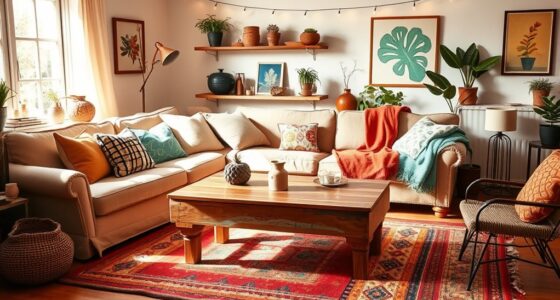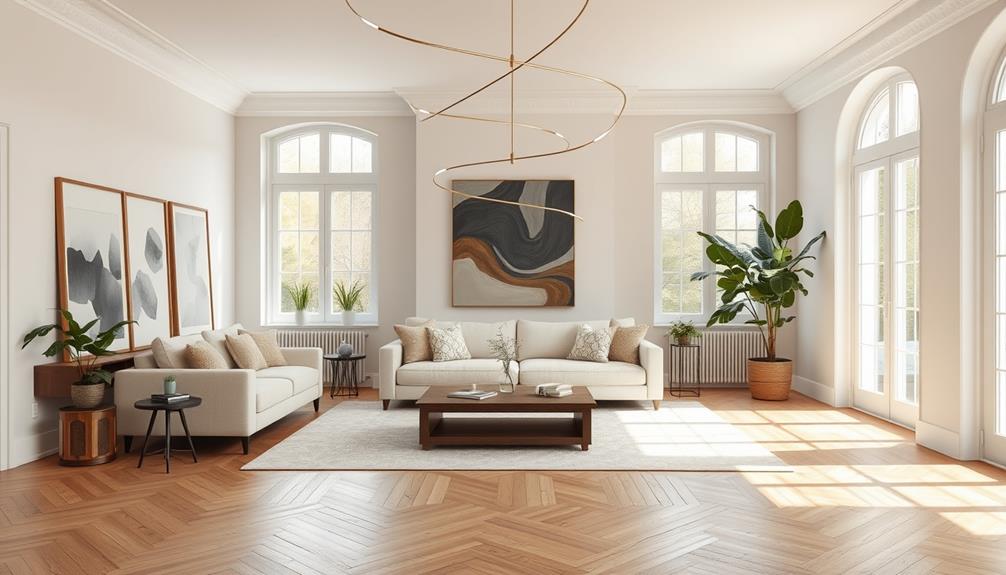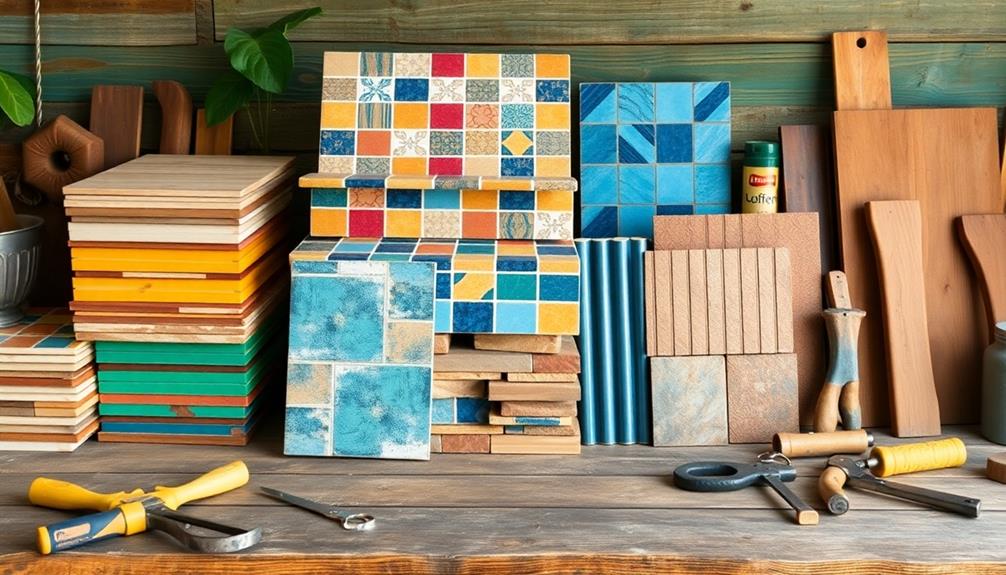In order to determine the cost of a bathroom remodel, begin by estimating the overall expenses involved. Typically, a remodel can range from $10,000 to $25,000. Take into consideration material costs, which usually make up about 60% of your total budget. Additionally, factor in labor costs, which tend to average around $70 per hour. It is important to create a detailed itemized list that outlines all components such as flooring, fixtures, and plumbing. Be sure to set aside a contingency fund of 10-20% to cover any unexpected expenses. Obtain multiple quotes to compare competitive pricing. By following these strategies, you will be well-prepared to budget effectively and ensure a smooth project flow. Explore more on this topic!
Key Takeaways
- Determine your budget range, typically between $10,000 to $25,000 for an average remodel; high-end projects can exceed $50,000.
- Break down costs into categories: materials (60% of total), labor (20%), and additional expenses like permits or specialty items.
- Factor in potential unexpected costs by budgeting an extra 10-20% for structural issues or design changes during the remodel.
- Choose budget-friendly materials and focus on cosmetic updates to minimize costs while maintaining style and functionality.
- Create a detailed itemized list of all materials and labor to ensure clarity and prevent overspending.
Understanding Bathroom Remodels
When it comes to bathroom remodels, understanding the scope and costs involved is essential. The average cost for a bathroom remodel in 2023 is around $11,550, but you can expect bathroom remodel costs to range from $10,000 to $25,000. High-end projects might even exceed $50,000, influenced by factors like size, materials used, and design complexity.
Additionally, considering the significance of selecting the right materials can lead to effective and lasting results, similar to how cold medications can provide effective relief during an illness.
Distinguishing between bathroom renovations and remodels is vital. Renovations often focus on cosmetic updates, while remodels involve significant changes, such as relocating plumbing fixtures, which can dramatically affect your remodel cost breakdown.
Key components that contribute to your project budget include fixtures, flooring, cabinets, lighting, and plumbing. It's wise to choose materials that enhance both functionality and aesthetic appeal.
Estimating Overall Costs
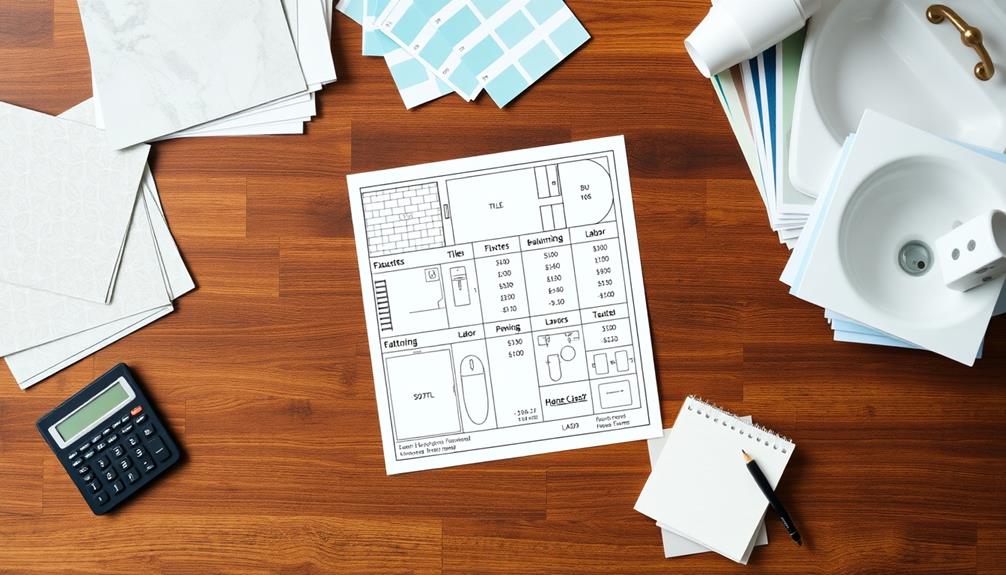
Estimating overall costs for a bathroom remodel requires a careful evaluation of several key factors. Start by determining the bathroom remodel cost based on the national average, which ranges from $10,000 to $25,000, with high-end projects exceeding $50,000. Estimating bathroom remodel cost also involves taking into account the size of the space, the quality of materials and fixtures, and the extent of the renovation. Additional expenses may arise from plumbing and electrical work, as well as any unexpected challenges that arise during the remodel. It’s important to create a detailed budget and allow for some flexibility to accommodate any unforeseen costs.
Size plays a vital role; half bathrooms typically cost between $3,000 and $15,000, while master bathrooms range from $5,000 to $30,000. Additionally, consider incorporating energy-efficient appliances, which can enhance both functionality and savings in the long run, contributing to a more sustainable remodel energy-efficient appliances.
Next, consider the materials chosen, which can account for about 60% of the total cost. These costs generally average between $2,000 and $10,000, depending on quality and type.
Labor costs are another significant factor, usually around $70 per hour, representing approximately 20% of the overall project cost, or between $1,300 and $4,300.
Labor Cost Considerations
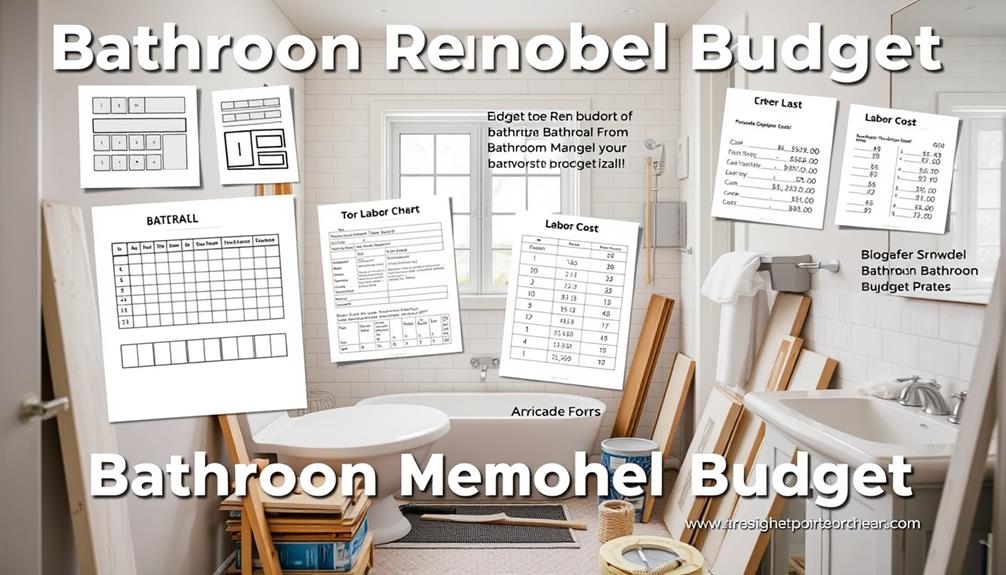
Understanding labor cost considerations is vital for accurately budgeting your bathroom remodel. The average labor cost in 2023 is approximately $70 per hour, which can greatly impact your overall project budget.
To create an accurate estimate, you need to decide between hourly rate and project-based pricing. Hourly rates can lead to fluctuating costs depending on the project's scope and duration, while project-based pricing offers a fixed total. Additionally, setting specific savings goals for your remodel can help you allocate funds more effectively and avoid overspending.
Utilizing RSMeans data can refine your labor cost calculations, ensuring you're using realistic figures based on employee capabilities and past experiences.
It's also essential to incorporate potential labor interruptions, such as supply issues or equipment malfunctions, into your estimates. This helps prevent underestimating expenses and keeps your budget intact.
Creating detailed itemized lists for labor tasks will provide a clearer breakdown of costs. This approach allows for more accurate budgeting and forecasting throughout your remodeling projects.
Material Cost Breakdown

Budgeting for a bathroom remodel hinges on effectively breaking down material costs, which can greatly influence your overall spending. Typically, material costs range from $2,000 to $10,000, making up 60% or more of your total remodeling expenses.
Understanding the emotional dysregulation involved in managing such projects can also be beneficial for maintaining a clear focus navigating emotional challenges.
Start by considering the flooring materials, which average between $56 and $103 per 100 square feet. Next, factor in countertops, where prices can range from $65 to $256 per linear foot, depending on your choice of material.
Shower installation costs also vary considerably, with average costs between $511 and $3,036 based on complexity and type.
Don't forget about the sinks; installation typically runs from $460 to $1,475, influenced by style and materials. When budgeting, include fixtures and plumbing costs as well. Basic toilets may cost between $200 and $500, while customized options can range from $800 to $2,100.
Lastly, if you're adding a vanity, make sure to account for its price in your material costs. By breaking down these expenses, you'll have a clearer understanding of your budget for a successful bathroom remodel.
Specialty and Additional Expenses
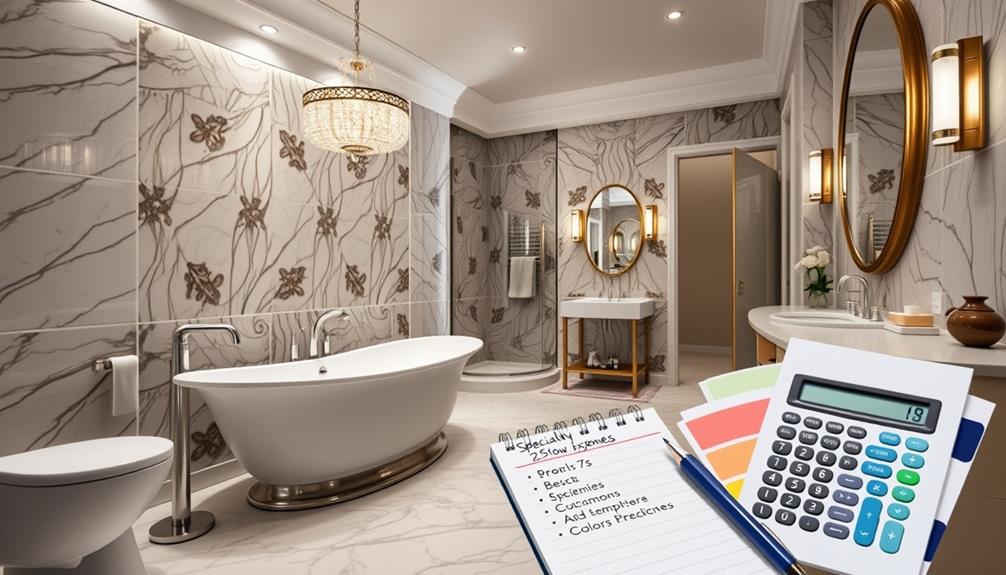
When planning your bathroom remodel, don't overlook the specialty and additional expenses that can quickly add up. These costs can greatly impact your overall cost, so it's essential to include them in your budget estimates.
For instance, just as with home security systems, where unexpected costs can arise due to various factors, bathroom renovations can also face similar surprises, including the need for cost considerations related to specialty items like unique fixtures and equipment rentals.
Here are some common specialty and additional expenses to take into account:
- Specialty items like unique fixtures and equipment rentals
- Permitting and inspection fees, which vary by location
- Unexpected expenses that can arise during the renovation process
To guarantee your project budget is realistic, factor in a gross profit margin (GPM) of 35% to 38% based on total project costs. Unexpected expenses can account for 10-20% of your total budget, so it's wise to prepare for surprises like structural issues or design changes.
Don't forget to check local regulations, as permitting and inspection fees can quickly add to your renovation costs.
Lastly, keep in mind that seasonal demand can affect labor and material prices, so timing your remodel can help mitigate specialty costs. By carefully planning for these expenses, you'll have a better chance of staying within your budget and achieving your desired results.
Cost Overruns and Surprises
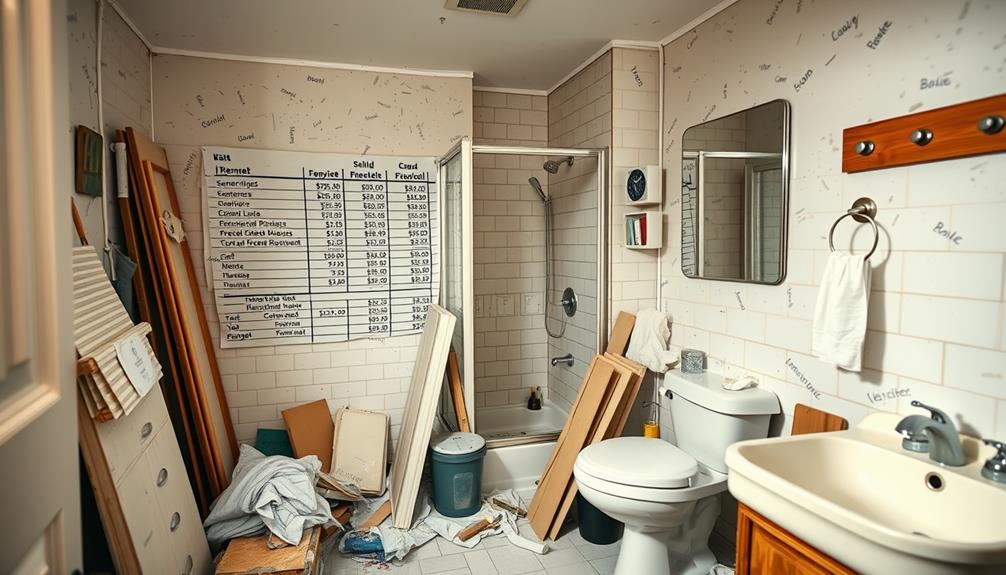
Cost overruns and unexpected surprises can easily derail your bathroom remodel budget if you're not careful. To keep your expenses in check, it's essential to anticipate common issues that might arise during the project. Structural issues like mold or plumbing problems can inflate your remodeling costs by 10-20%. Mid-project design changes also lead to additional costs, so finalize your designs early to avoid these pitfalls.
Here's a table that highlights potential cost overruns you should be aware of:
| Type of Cost | Potential Overrun Sources | Tips for Management |
|---|---|---|
| Structural Issues | Mold, plumbing problems | Inspect thoroughly before starting |
| Design Changes | Last-minute alterations | Finalize designs up front |
| Material Delivery | Delays causing idle labor | Order materials early |
| Permitting Fees | Varies by region | Research local fees beforehand |
| Seasonal Demand | Higher labor and materials costs | Plan renovations in the off-season |
Cost-Saving Strategies
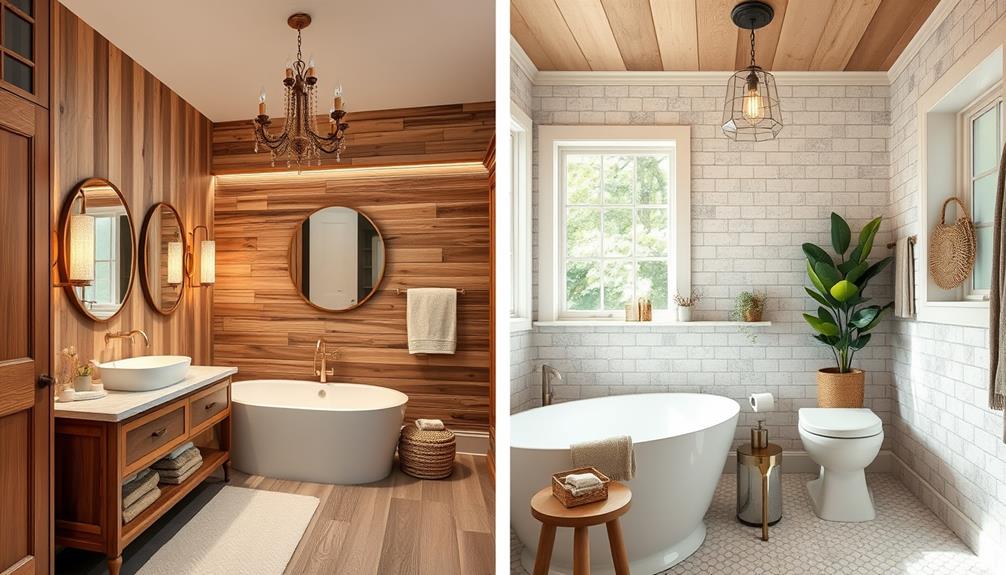
When planning your bathroom remodel, consider maintaining the existing layout to save on plumbing and electrical costs.
Choosing budget-friendly materials can also help you stick to your budget without sacrificing style.
Maintain Existing Layout
Maintaining the existing layout of your bathroom can be a smart way to save money during a remodel. By keeping the same arrangement, you can avoid costly plumbing and electrical rerouting, potentially saving up to 30% on your remodeling costs.
This approach also minimizes labor charges, which can account for around 20% of your total expenses. Additionally, focusing on mood boards essential can help visualize your desired cosmetic updates, ensuring a cohesive design direction.
Here are a few cost-saving strategies to evaluate:
- Focus on cosmetic improvements: Update existing fixtures instead of replacing them entirely.
- Explore cost-effective upgrades: Refinish cabinets or change hardware rather than doing a full renovation.
- Stay within budget: Aim for minor renovations that typically cost between $2,000 to $10,000.
Select Budget-Friendly Materials
Selecting budget-friendly materials is essential for keeping your bathroom remodel within financial reach.
Start by choosing basic shower pans instead of custom options; this decision can greatly cut down costs while still delivering functionality. For your flooring or walls, opt for rectangular tiles over intricate patterns like herringbone. This choice helps maintain an appealing aesthetic without inflating your material costs.
Additionally, you might consider best vacuums for dust removal in 2024 to guarantee your renovation space stays clean and free of dust during the remodel process.
Next, consider economy-grade fixtures. Ranging from $600 to $2,600, they keep your overall budget in check without sacrificing quality. Accessories like towel racks and mirrors can also enhance your space without substantial expense, making them wise additions.
If you're looking for a low-cost alternative to replacing existing materials, think about repainting your tiles and fixtures. This simple yet effective strategy allows you to refresh your bathroom's appearance while saving on material costs.
Budgeting for Unexpected Costs

Unexpected costs can pop up during a bathroom remodel, so it's crucial to plan ahead. To guarantee you're well-prepared, you should budget an additional 10-20% of your total remodeling costs to cover unexpected expenses.
By doing this, you'll have a safety net for those unforeseen issues that might arise. Similar to steering through a divorce process, anticipating potential challenges can greatly ease your experience.
Here are a few common unexpected expenses to think about:
- Structural issues, like mold or plumbing problems
- Delays in material delivery or mid-project design changes
- Permitting and inspection fees
Setting aside contingency funds specifically for these scenarios can save you from financial strain later.
Also, keep an eye on seasonal demand fluctuations that may affect labor and material prices; adjusting your budget accordingly can help you avoid surprises.
Finalizing Your Estimate
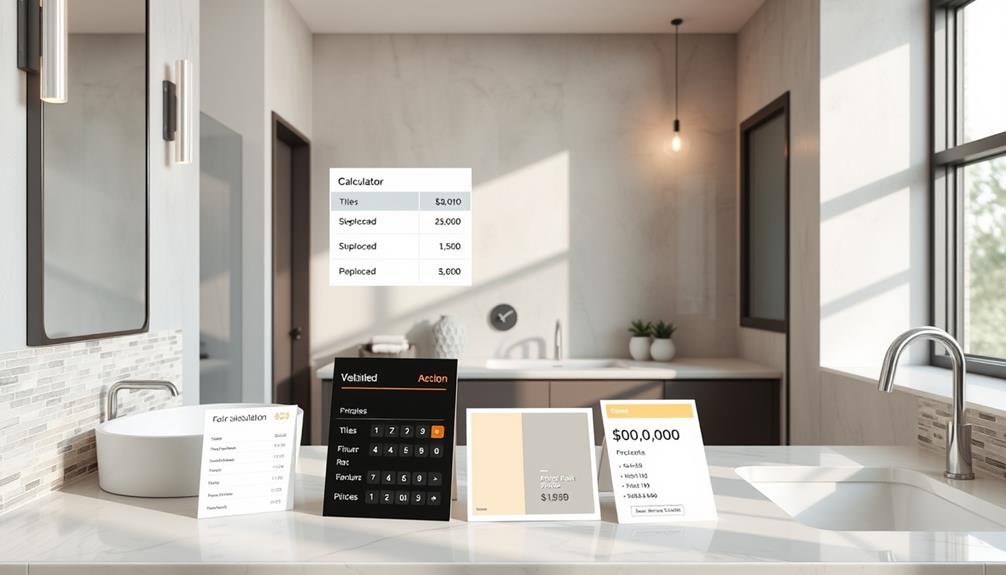
Once you've accounted for potential surprises in your budget, it's time to finalize your estimate for the bathroom remodel. Start by creating a detailed itemized list of all materials and labor costs. Gathering pricing from multiple suppliers will guarantee accuracy and help you identify the most cost-effective options available online, such as best websites to earn money online.
Break down expenses based on specific features like flooring, fixtures, and plumbing; this clarity will help you and any clients understand exactly what's included.
Don't forget to incorporate a contingency fund of 10-20% of your total estimated cost to cover unexpected expenses that might arise during the project. It's crucial to differentiate between preliminary estimates and fixed-price proposals, setting clear expectations about potential cost fluctuations.
As the project progresses, regularly review and update your estimates. Keep detailed records of all expenses, making sure they align with your finalized budget.
This diligence not only helps you stay on track but also prepares you to address any financial surprises confidently. By following these steps, you'll have a thorough and realistic estimate that guides your bathroom remodel effectively.
Tips for Accurate Calculations

Accurate calculations are essential for a successful bathroom remodel, and a few key strategies can help you achieve this. By following these tips, you can better manage your bathroom remodeling costs and avoid surprises.
For instance, maintaining an updated price list for materials and labor can prevent overspending, much like understanding the hamster price guide helps in budgeting for pet care.
- Maintain an updated price list for materials and labor.
- Create itemized lists and use square footage calculations.
- Set aside a contingency fund for unexpected expenses.
Start by gathering multiple quotes from contractors and suppliers to guarantee competitive rates. This will help refine your cost estimator and provide a clearer picture of your overall budget.
Conduct thorough site assessments to account for all necessary labor and materials, and review past estimates from similar projects for enhanced accuracy.
Don't forget to include a contingency fund of 10-20% of your total remodeling cost. This will cover unexpected expenses, like structural issues or design changes, that may arise during the project.
Frequently Asked Questions
How Do You Measure a Bathroom for Remodeling?
To measure a bathroom for remodeling, you start by measuring the length and width in feet. Don't forget to check the height of the walls and document fixture dimensions for accurate planning and layout.
How Do I Quote a Bathroom Renovation?
Quoting a bathroom renovation's like piecing together a puzzle. Start by evaluating the space, itemizing materials and labor costs, and including a buffer for surprises. Communicate openly to manage expectations and guarantee clarity throughout.
How to Estimate Labor Cost for a Bathroom Remodel?
To estimate labor costs, check local hourly rates for plumbers and electricians, calculate the hours needed for each task, and consider potential interruptions. Itemize tasks for a clear, accurate budget. Don't forget market variations!
What Percentage Should I Spend on a Bathroom Remodel?
You should spend about 5% to 10% of your home's value on a bathroom remodel. This balance helps guarantee your investment pays off while enhancing your space's functionality and aesthetic appeal.
Conclusion
By now, you've got a solid grasp of how to calculate your bathroom remodel costs. As you plan, consider all the factors we discussed, from labor to materials, and don't forget to budget for those unexpected expenses. After all, wouldn't it be a shame to run out of funds just as you're about to create your dream space? Stay organized, keep your priorities straight, and you'll be well on your way to a successful remodel!



